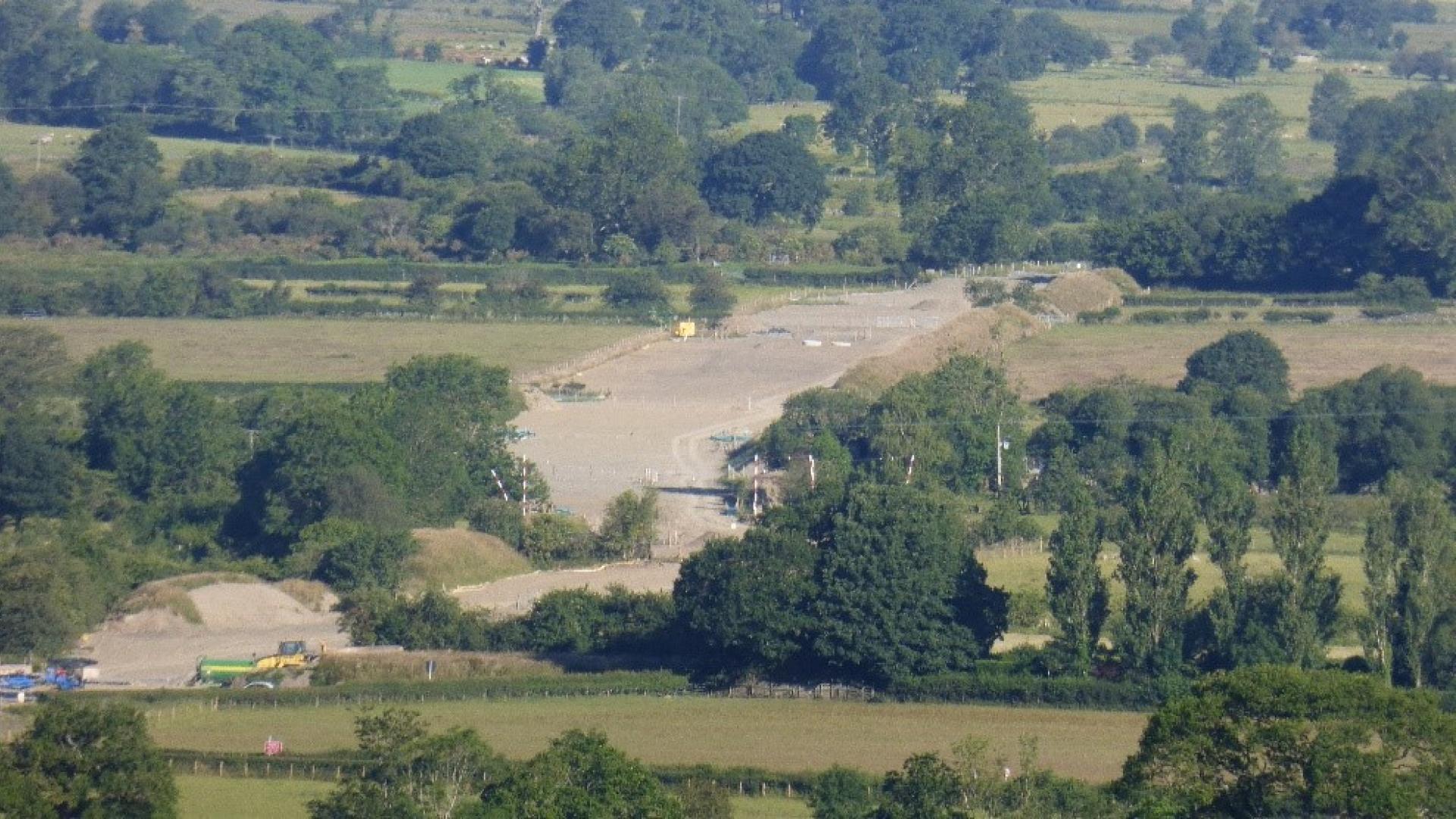Two huge water pipes are being dug in a vast 20-mile trench leaving a 130-foot wide scar, the width of a dual-carriageway, behind it (see photos 1 and 2). It’s part of a £300 million project to connect Thirlmere reservoir to the West Coast of Cumbria. In total along the whole pipeline project nearly 8 miles of hedgerows are being removed and 48 acres of woodland, including nearly 10 acres of ancient woodland, destroyed. It’s a project that brings negligible benefit to the Park, only wildlife destruction, and disruption to the lives of locals and the local economy. This is an update from my 1st blog last year[i].
Photo 1: Pipeline excavation in Underskiddaw
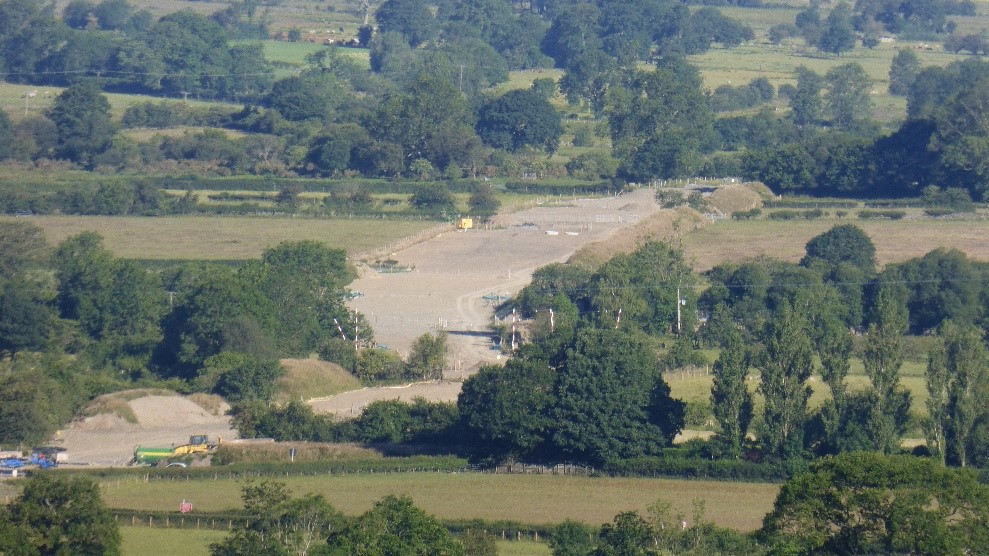
Photo 2: Diggers at work on the pipeline
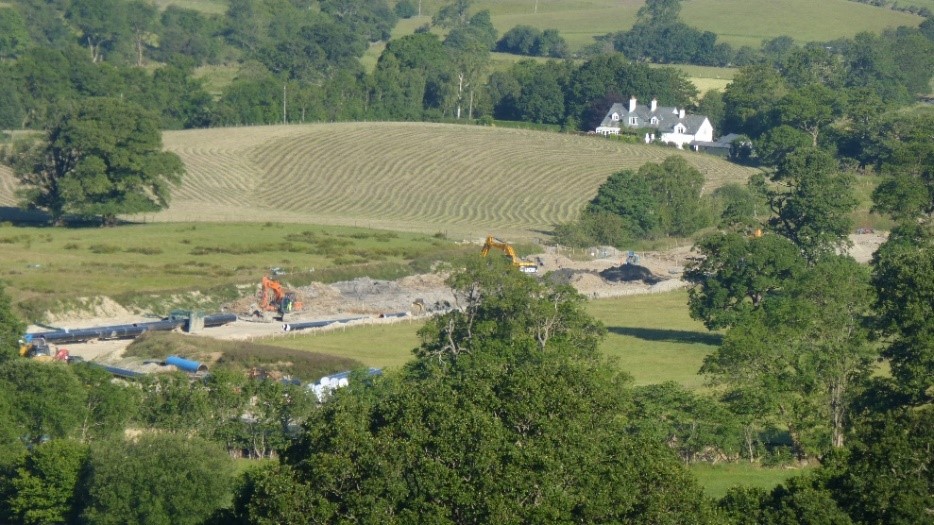

The project is a big gamble with two of Britain’s most endangered wildlife species – Pearl Mussels and Vendace – at risk
The reason for the pipeline is that the Environment Agency are withdrawing the licence to extract water from Ennerdale in 2022 to protect the rare freshwater pearl mussels in it. So United Utilities have to find an alternative source of water. This alone is inexplicable since nearby Sellafield are allowed to go on extracting water.[ii]
United Utilities proposed three options back in 2013 and the one they chose has by far the biggest impact on the Lake District National Park. Amazingly the National Park Authority approved the plan, with barely a murmur of discontent. This is despite the fact that a National Park should only approve a project like this when ‘there is no practical alternative’[iii]. Perhaps most perplexing is that there is already a river (first the Greta and then the Derwent) starting and ending in the same place as the pipeline. Can’t drinking water be extracted from rivers? Of course it can. London, for example, extracts 70% of its water from rivers[iv]. So, the whole destructive, expensive pipeline mimics the existing water flow of nature, and isn’t needed.
The pipeline goes past the river courses for Derwentwater and Bassenthwaite, and any run-off from the pipeline diggings will go into the water courses that feed these two lakes. These two lakes are the only places in the entire UK that a small fish called the Vendace survives naturally. It is highly endangered too: just one notch below the Pearl Mussels in the grim league table of endangered-ness.[v] The Vendace is at risk from two main threats: phosphorus and sediments in the water[vi].
This is the gamble that the Environment Agency and the National Park are making: the pearl mussels will be helped by stopping water extraction from Ennerdale, and that the Vendace won’t be harmed by the increase in sediment run-off from the pipeline work. In other words, there is no guarantee that stopping the withdrawal of water will either save the mussels, or that the Vendace won’t be killed off. It’s also a very strange wildlife conservation strategy that entails possibly sacrificing one set of wildlife to save another. Imagine if we put lions at risk to save tigers, or pandas to save polar bears.
Photo 3: A wildlife marsh just before pipeline excavation began, and after (inset)

The Environment Agency used to try and stop sediment run-off into Bassenthwaite
Only 10 years ago the Environment Agency, the National Park and others were trying to reduce sediment run-off into Derwent Water and Bassenthwaite. Ploughing was frowned upon[vii]. Millions were spent on clean up.[viii] Now they have approved a pipeline that is greatly increasing sediment run-off to the only two lakes in the UK where the Vendace survives.
The rivers and streams ‘run like milk’ with sediment
Many local farmers have commented on how the streams that pass through the pipeline workings ‘run like milk’ at different stages of the digging. The efforts to capture sediment always seem to be one step behind. It’s still possible to see pipes draining water with no filtering at all. On occasions the workings have over-flowed with muddy water pouring into the watercourses (see photos 4 and 5). The locals who have tackled the construction teams have just been told that ‘The Environment Agency is happy’, effectively shutting down complaints.
Photo 4: Pipeline workings with polluted water overflowing netting
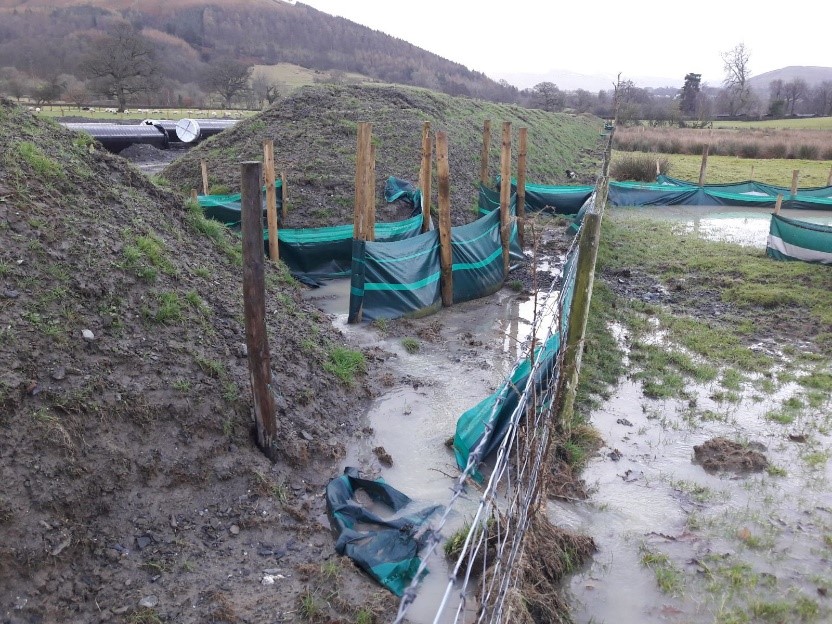
Photo 5: Pipeline run-off polluted with sediment in the water course
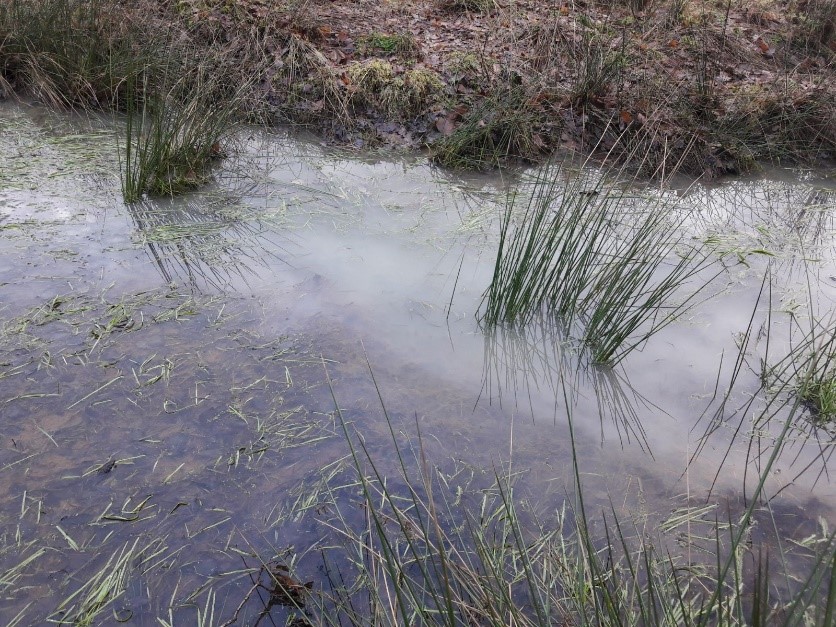
Another worry is that the Environment Agency have left United Utilities to do their own monitoring[ix] of turbidity and sediment run-off: disappointing given that United Utilities have a clear conflict of interest. Indeed, when a friend asked the Environment Agency how locals could help monitor the environmental impact of the pipeline, they were told ‘under no circumstances should members of the public access the construction sites’[x]. Not only does this portray a breath-taking ignorance of the numerous crossing points giving the public access, it suggests they are not really interested in finding out the environmental impact of the pipeline from independent sources. Indeed, the number the Environment Agency suggest ringing to report sediment in the water is nowhere to be seen on any of the pipeline signage. So, in trying to monitor the environmental impact of the pipeline, the Environment Agency has chosen United Utilities and contractor Farrans/Roadbridge with their massive vested interest in not revealing any problems and made no effort to get the input of locals who will be stuck with the legacy of the pipeline for years to come. Not a good choice in my view.
Wholesale wildlife destruction to clear the pipeline route
It’s not just sediment and the Vendace that is the impact on wildlife. One farmer told me that United Utilities wanted to fell trees and hedgerows ‘just in case’ the pipeline went one way or another on his land. Another example of this careless approach to wildlife is highly visible on the A66 just outside Keswick, where a huge gap in the trees has been created, though the pipeline follows a different route 150 yards away (see photo 6).
Photo 6: Gap where trees felled on A66 while pipeline took a different route
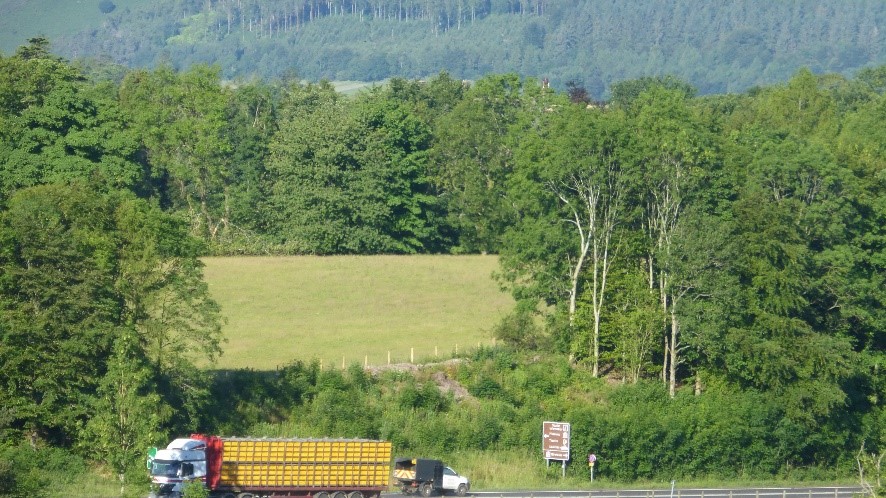
Photo 7: Burr oak described as ‘most valuable in UK’ by tree surgeon
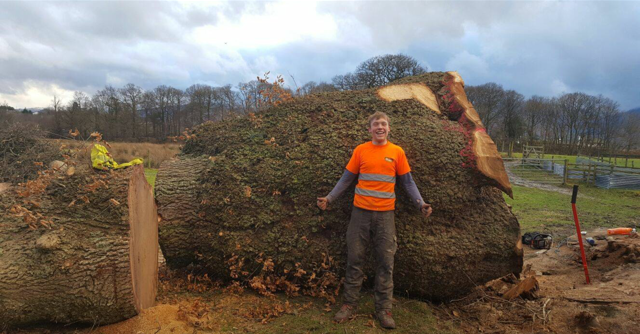
Last year, as a result of the impending pipeline a 300-year-old ‘burr oak’ was felled on its route. The tree surgeons who did the work described it as ‘the most valuable tree in the entire United Kingdom’. United Utilities admit that it was this tree or another that had to come down to clear the pipeline route.
Another magnificent oak tree was saved from the chainsaw, not by the Park Authority, but rather the swift action of locals who spotted the X mark on the tree and persuaded United Utilities to tweak the pipeline route. The lack of visible concern of the National Park Authority about wildlife destruction is inexplicable. The National Park has been great at their paperwork: over 100 documents on their website about the pipeline. Park documentation said ‘the proposals have sought to avoid tree and woodland loss where-ever possible’[xi]. I wonder how many locals and farmers along the pipeline route would agree with that assessment.
Chaos and disorganisation are the order of the day in pipeline construction
Perhaps people like me would be more re-assured that the pipeline was likely to do minimal damage on the environment, if the project appeared well run and organised. Nothing could be further from the reality. In our section of pipeline every deadline set for completion has been missed. United Utilities told local farmers that they would be planting grass by October 2017, and then February 2018. At a drop-in session last November, they assured me their work would be complete locally by end May 2018. Well they are still working now and it’s July. They are just ignoring the project notices on their site entrances which say they will be done by the end of May (see photo 8). Our local depot was meant to be gone by now but is now extended to be used to the end of the year. Ironically United Utilities are now claiming they are under budget and ahead of schedule. This is clearly an inaccurate statement in regards to the work in our area, but fine details aren’t United Utilities’ strongpoint (they claim that the Pipeline avoids ‘urban areas’ when it goes bang through the middle of Keswick). More on this later.
Photo 8: The signs saying completion in May 2018. Still digging in July 2018

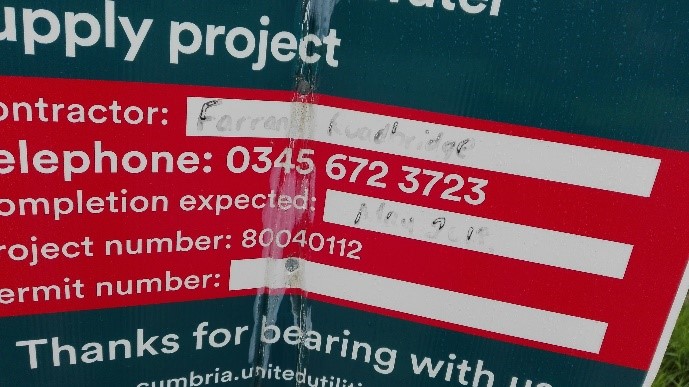
The chaos doesn’t end there. The residents were told a local road would be closed in late May; they changed their minds with a day’s notice and closed the road a month later. Unreassuringly farmers in Thirlmere are being told that Farrans/Roadbridge have learnt a lot about how to do things better by their initial work in our patch. Learning on the job to this extent is hardly the hallmark of a constructor that knows what it’s doing. Every local site where water is being drained away from construction digging has got progressively more filters and pumps. Hardly reassuring about how good the provision was to prevent sediment run-off in the early days.
And if this is the chaos, incompetence and disorganisation we can see, is anybody surprised we have so little faith that United Utilities can be trusted to do their own sediment monitoring and environmental impact?
The impact on lives and livelihoods
It’s not just the wildlife in the National Park that are suffering; it’s the local people and economy too. The pipeline is going directly under Keswick, under the river Greta and across the A66 (the biggest east/west main road in the Park). Roads are being blocked for weeks or months on end. Local businesses are affected. Tourism is being disrupted. Farmers are having their land sliced in two and put out of use for years. There are five tunnels, most of them going under Keswick, including right next to the main primary school. The constructors have been given permission to work 24 hours a day. They frequently do work on Sundays. Considerate Constructors? I think not.
By my calculation based on planning documents, there are 400,000 cubic metres of waste material to be disposed of[xii]. Watching our local depot, I reckoned that there are least 200 vehicles coming and going each day. That’s 60,000 journeys a year from our depot alone, scaling up to several million journeys for the Thirlmere to Cockermouth section of the pipeline.
It appears that the Park has been poor at negotiating with United Utilities. In the North York Moors National Park, where an enormous Potash mine is being built, much tighter planning control has been imposed to reduce noise, traffic and visual pollution[xiii]. Construction vehicles don’t have beepers. Generators are housed in acoustic padding, and construction sites have acoustic fences. Construction lorry numbers are limited on a daily basis. And there are two dedicated planning officials for the project paid by the mine owner. None of these kinds of controls exist with the United Utilities pipeline. And on a summer’s day when pipeline vehicles beep endlessly I wish they did.
I have been told to worry less about it and that this kind of pipeline has a great track record in restoring land to its original setting. Sadly, the local track record with United Utilities is not good. The Headteacher of Keswick School described getting United Utilities to sort out the drainage of its playing field as a ‘nightmare’ which took six years[xiv] and what was a once playing field is now only fit for grazing.
Poor compensation for the Park and the People
Since this is a project that brings minimal benefit to the Park, I wish I could tell you that United Utilities are compensating the Park Authority handsomely to explain why the Park gave permission. Sadly not. The Park will receive just over £260,000[xv] in compensation to plant new trees, less than 0.1% of the cost of the pipeline. The pipeline contractors are from Ireland so it seems unlikely that many jobs are being created in the Park. Indeed, just £52 million of the £300 million is being spent in Cumbria[xvi], let alone in the Park, itself according to planning documents. United Utilities have set up a ‘Legacy Fund’ (of an unspecified size, hardly encouraging in itself) to help with the impact of the pipeline but limited to local registered charities and ‘community-based organisations’[xvii]. So apparently the local tourist bodies can’t put together a campaign to encourage visitors. And of the grants so far, just a handful have been approved for the Keswick area, which is being hammered hardest by the pipeline. The rest have gone inexplicably to the West Coast.
Why isn’t the National Park Authority standing up for its wildlife?
Whatever their motives for approving the pipeline, it is the Lake District and its wildlife, residents and tourists that are the victims. It’s tragic that the National Park doesn’t have the courage to defend its wildlife; happy it would seem, to see ancient woodland replaced with new plantations. Happy to risk one highly endangered species for another. But nothing can replace 300-year-old trees, ancient woodlands, or the decades old hedgerows that are being removed. It’s like pretending that a new housing estate makes up for the destruction of an ancient castle, or a stately home. That is to say nothing about the impact on Vendace. The visible scars will be permanent: the pipeline will have over 200 structures left above ground along its route, some as big as 20 feet by 10 feet slabs of concrete[xviii].
For those who thought that National Park status, or even World Heritage status, would protect wildlife, nature and the Lake District from major developments, you’d better think again. The floods of 2015 were a natural disaster due to freak levels of rainfall. The pipeline is a self-inflicted, wholly avoidable, disaster. And those who should be protecting this World Heritage landscape have given permission.
Joe Saxton lives in Underskiddaw, Keswick. He can be contacted on joe.saxton@btinternet.com
Post-script: This blog was emailed directly to around 200 stakeholders associated with the pipeline including all the National Park Authority’s 20 or so members of the main Governing body in July and early August. One parish clerk has responded. None of my assertions have been challenged or disputed. The signs in photo 8 have now been changed to say 2019. No Park officials have followed up about the allegations of water pollution or breaking of planning conditions.
[iii] This is what was originally called the Silkin Test now replaced National Planning Policy Framework (2012), paragraphs 115/116, with a slightly different wording.
[v] http://www.iucnredlist.org/details/135640/0 for the Vendace. http://www.iucnredlist.org/details/12799/0 for the mussels
[vii] http://www.cwherald.com/a/archive/locals-to-help-solve-bassenthwaite-lake-s-nutrient-problems.220502.html
http://closedprogrammes.hlf.org.uk/ourproject/Pages/BassenthwaiteReflections.aspx
https://www.ceh.ac.uk/bassenthwaite-lake-uk-lake-restoration-case-study
[viii] http://www.independent.co.uk/environment/extinct-fish-found-in-the-lake-district-after-millions-spent-on-clean-up-work-9782933.html
[ix] Email from Helen Reynolds of the Environment Agency dated 31st October 2017 to Megan Williams
[x] Email from Helen Reynolds of the Environment Agency dated 31st October 2017 to Megan Williams
[xi] LDNPA planning document for 7/2016/2027 para 5.69
[xii] LDNPA planning document for 7/2016/2027 para 5.112
[xiii] Farming Today on Radio 4 on 26th June 2018
[xiv] Keswick Reminder article, February 2018
[xv] LDNPA planning document for 7/2016/2027 para 5.71
[xvi] LDNPA planning document for 7/2016/2027 para 5.120
[xviii] Confirmed by Farrans/Roadbridge representative during open meeting with Underskiddaw Parish Council
This is so sad. But you've
This is so sad. But you've done some really good research that should be known about more widely. Have you sent this to any freelance reporters? Would be good to get it in the national press.

